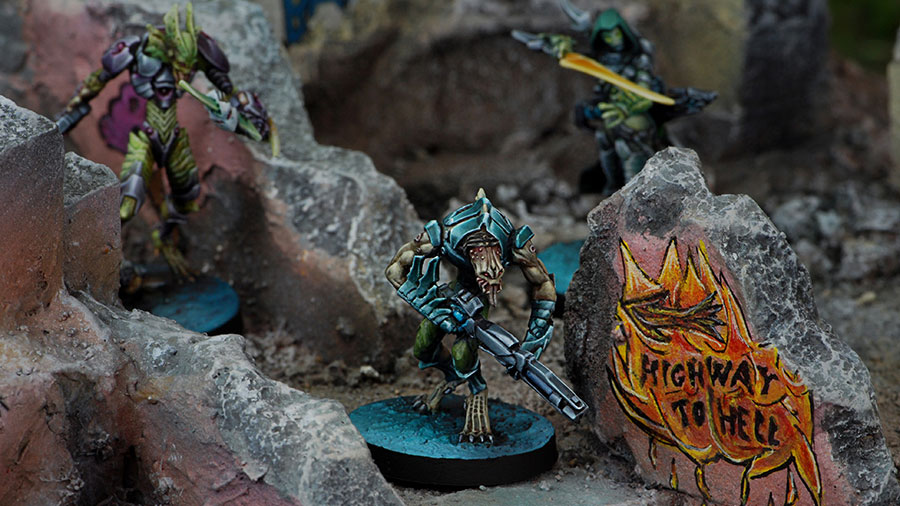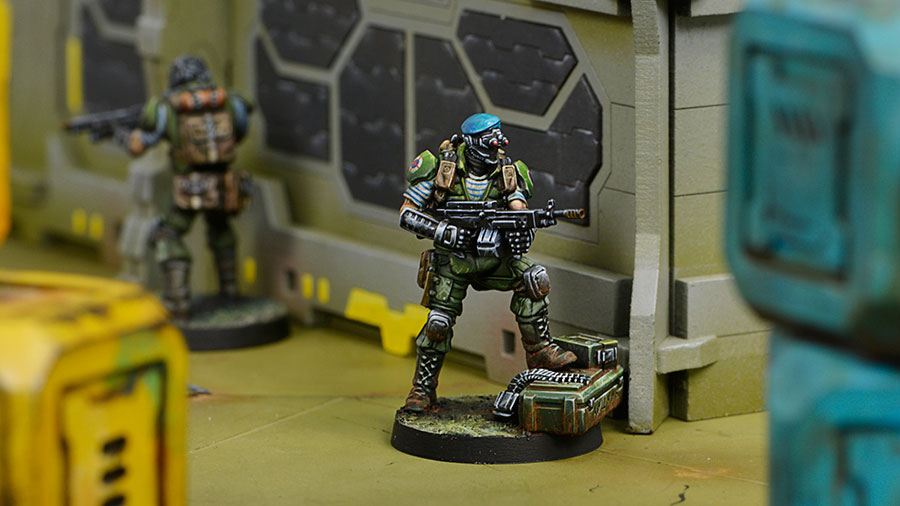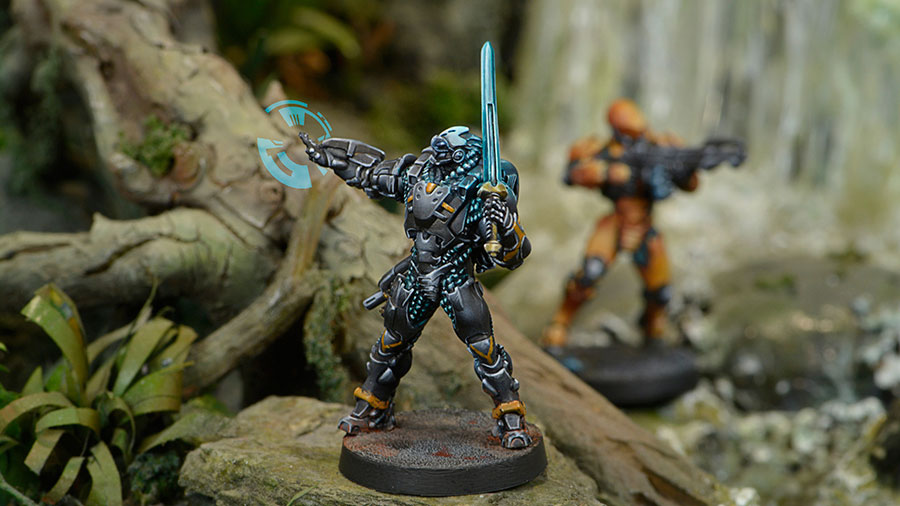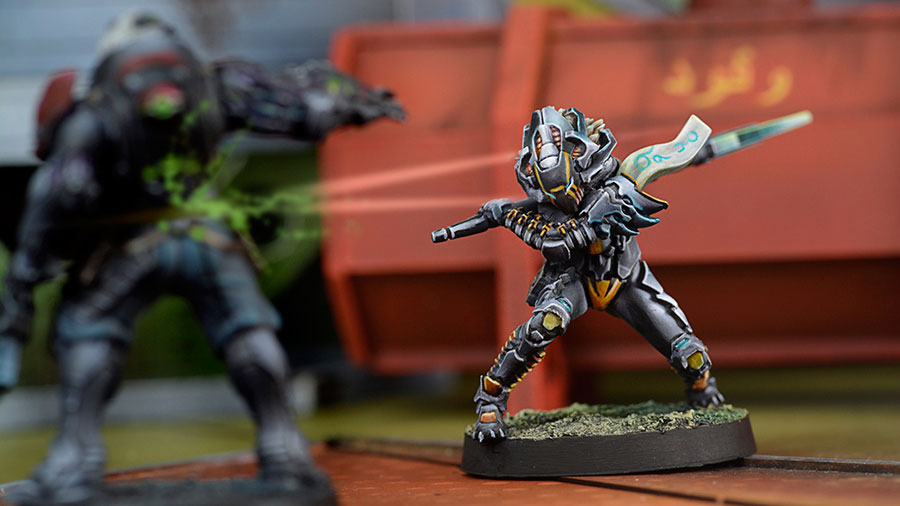Infinity Tactics 101: Using Camouflage
Following my recent trend on sneaking around the battlefield's of Infinity, lets wrap up the conversation and talk about Camouflage. This special rule helps represent the stealthiest troops on the battlefield, moving around undetected until the most opportune moment to strike. Camouflage is an incredibly powerful tool that you can use to protect your models while they move into position. In addition to protecting you from enemy fire, it also masks the identity of the model itself, your opponent won't know if they're about to be shot at by a missile launcher or a rifle, or cut down ruthlessly in close combat.

Camouflaged
When deploying a model with any level (other than Mimetism) of Camouflage, you're likely going to deploy the model in a Camouflaged marker state. This will mask the actual identity of the model from your opponent, forcing them to guess at the true nature of the marker. This is incredibly troublesome in armies with access to a variety of camouflage models (like Ariadna), since it will make it more difficult to discern what it is. While you are in the marker state, your opponent will not be able to directly target you with attacks (other Intuitive Attack) until you are revealed, though can still hit you with Direct and Impact Template weapons which target another model, and also happen to hit your Camouflaged marker in the process.
When in the Camouflaged state, the model cannot be (directly) targeted by Attacks, troopers cannot move into base contact with it, and it will have a 360° LOF.
The Camouflaged state is broken under any of these conditions:
- Model declares a skill other than Short Movement without a dice roll, or Cautious Movement.
- Model moves into base to base contact with an enemy trooper.
- Model has been Discovered.
- The Camouflaged trooper receives a successful hit that forces him to make an ARM/BTS Roll (or suffers a Critical Hit), usually from a template weapon or Intuitive Attack.
- Model becomes Impetuous.
When you are revealed, you will count as having been revealed for the entirety of that order, so if you move, then declare a Surprise Shot, you will be visible to all enemies for the entirety of your move.
Camouflage and Hiding is a skill (shorthand CH), while Camouflaged is a state which a model can be in. For most of this article, I'll be talking about models in the Camouflaged State, the CH skill is simply what allows you to use this state.
Hidden Deployment
Models with TO Camo (CH: Level 3, Thermoptic Camouflage), have an added ability where they can be deployed on the table without a marker at all, but instead you secretly note the position of the model. While in the Hidden state, the model will not generate orders for the order pool, but can spend their own order normally, should they wish to activate. You can also ARO with a model hidden in this way, which is really good for catching your opponent off guard. When you activate a hidden model, you place the model or appropriate Camouflaged state marker in the spot where the model is.
Camouflaged Movement and Delaying AROs
When you activate a model that is in a Camouflaged state, as with activating any model, your opponent is allowed to declare an ARO. The only ARO's available against a Camouflaged marker are Discover, Change Facing, or Dodge, alternatively , they can opt to delay their ARO. If the enemy model delays, and your second skill reveals the Camouflage marker, they may then declare an ARO like normal, though if your second skill does not reveal you though, their ARO is lost.
A Hidden Deployed model reacting to an enemy Camouflaged model can also opt to delay their ARO, but as soon as you announce that you are delaying, you must place the Camouflaged marker where that model was hiding.
Camouflaged models automatically have Stealth, which will also prevent enemy models without LOF from declaring any ARO's against you. Read more about Stealth in my recent article about Stealth and Silent.
Discover
You cannot declare an Attack order against a Camouflaged model, until it's been revealed through an action of their own, or until it's been Discovered. Discover is a short movement skill, as well as an ARO, which uses your WIP, modified by range, cover, camo, visibility, etc., like a BS Attack. If your Discover attempt is Successful then the Camoflauged model will be revealed. Be careful though, if you declare Discover against a model, and they elect then to shoot you, it will not be face-to-face, and your Discover ARO will be wasted. If the model attempting the Discover fails, they will not be able to attempt to Discover that marker for the rest of the turn (if somehow that marker were to be otherwise revealed, then camouflaged again, it would be a new marker, so you could attempt to Discover the new Camouflage marker.
Camouflaged Attacking
All levels of CH, other than Mimetism, allow you to perform Surprise Shots (ranged) and Surprise Attacks (melee). These impose penalties on the enemy when you declare an attack action, during an order, which you begin in the Camouflaged state. This makes attacking from the Camouflaged state incredibly potent and makes it more difficult for your opponent to avoid your attacks, or fight back. Doing these actions will reveal you, as they are not short movement skills.
Surprise Shot
In the Active Turn, instead of declaring a BS Attack skill, you can instead declare Surprise Shot. This imposes an additional -3 mod to your opponents dice roll in any face-to-face roll made that order, simply meaning they will have -3 to any Dodge attempt, or -3 to shoot back. This is cumulative with any other penalties they would suffer, so if they elect to BS attack, they will also (without MSV) suffer a penalty from Camouflage or TO Camouflage, range, cover, etc. It's quite possible with a surprise attack, range, camo, and cover mods, that you can put your opponent at a -12 to shoot you back!
Surprise Attack
Just like Surprise Shot, a Surprise Attack imposes a penalty on the opponent, but for a CC Attack instead. The opponent's penalty for a Surprise Attack is -6, which also then stacks with any other modifiers (including of Martial Art)s, to any face-to-face roll made in that order. If you were in a position that you could be shot at (like having been in their LOF during the order), then this -6 will apply to their BS Attack, similarly if they decide to take a swing at you, the -6 will apply to their CC Attack.
The opponent penalty for both Surprise Shot and Surprise Attack only applies to face-to-face rolls. If you come out of camouflage to perform a BS Attack with a Chain Rifle, and your opponent Dodges, their Dodge is a Normal Roll, and thus not affected by any of these penalties.
Mines & Minelayer
A common piece of equipment, especially among sneaky camouflaged models, are Mines, additionally, some models have the Minelayer skill, which allows you to start with a mine deployed on the table. When you deploy a mine, you're going to place a S2 Camouflaged marker on the table. Like any other Camouflaged marker, it needs to be discovered before it can be attacked. Minelayer as I mentioned, allows you to start with a mine deployed, anywhere in the model's Zone of Control, and in a spot that model could have deployed in himself. What is under that marker is secret information that your opponent won't know until they either use Discover against the marker, or until it blows up in their face.
Re-camouflaging
After a Camouflaged model has revealed itself (hopefully after performing some sort of surprise attack), you may want to have it enter a Camouflaged state again. To do this, you must be out of LOF of the enemy, and spend an Entire Order skill to do so. As long as those requirements are met, you can replace the model with a Camouflaged marker again.
This Entire Order is not a Cautious Move or Short Movement Skill, so it is not affected by the Stealth rule, meaning it will trigger AROs in their Zone of Control as normal. If your opponent themselves has any hidden models that can see you attempting to enter Camouflage again, after you declare the order, your opponent can ARO to reveal their hidden model. Since you are now in LOF of an enemy, your skill is wasted and if they declare an attack, it will be unopposed... bad news!
If you are attempting to enter the Camouflaged state while in the Hacking Area of an enemy Hacker, they will be able to declare a Hacking ARO as normal. It would appear that if they're successful and you have to take a BTS roll, it will negate you entering Camouflaged, though it does require some clarification in the rules.
Special Camouflage
In addition to standard Camouflage and TO Camo, there are two special levels of Camouflage, Ambush Camo and Limited Camo. These are less widely used, but incredibly important to understand how they function, especially when they're used against you!
Camouflage Level 1: Mimetism
Not really a special level of the skill, Mimetism is the first level of Camouflage and Hiding. It doesn't allow you to use any of the fun rules I mentioned above, though it does provide you with a bit of protection, giving the enemy -3 at attempts to shoot you. This can be mitigated by a Multispectral Visor, and has no effect on direct template weapons, but it is still an immensely helpful skill for putting face to face rolls in your favor.
Camouflage Level X: Ambush Camouflage
Ambush Camouflage works exactly like standard Camouflage, additionally, like a Minelayer, during deployment you are allowed to place another Camouflage marker in his Zone of Control, following the models own rules for deployment. This additional Camouflage marker is a decoy and can do nothing, other than confuse your opponent as to what it may be. When the model with Ambush Camouflage is revealed during the game, the decoy marker is removed. This is a great skill to make your opponent think you have more models than you actually do, or for setting an ambush for someone who may think that they need to clear a mine.
Camouflage Level Y: Limited Camouflage
This skill allows a model to deploy in the Camouflaged state, but doesn't benefit from Camouflage in any other way. The model does not benefit from CH:Mimetism or CH:Camouflage, unless specifically noted in their skills, and they cannot re-enter the Camouflage state. In essence, this will allow you to perform a single Surprise Shot/Attack, and as a Camouflaged marker, your opponent won't know what model you set up during deployment.

Conclusion
All of these skills are designed to give you an information advantage over your opponent. A Camouflaged marker could be hiding anything from an innocuous decoy, to a full fledged murder machine. Hiding a Killer Hacker, specifically left in your opponent's Hacking Area, can quickly turn the tide after they declare a Hacking attack against another of your models. Similarly having a mess of camouflage models in the middle of the board can greatly slow your opponent's advance, unsure of what threats they're facing as they move. Camouflaged markers reduce your opponents efficiency as they spend orders Discovering them, or risking enduring mines and surprise shotguns.
I'm personally a big fan of these rules, and it's rare that I don't have at least one in any given army that I play, and often two or more (or four or more in Ariadna). Asymmetrical warfare in Infinity is probably my favorite aspect of the game, and nothing facilitates it as much as being able to surprise your opponent with a shotgun in the back.






